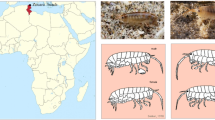Abstract
The need to compare the distributions of directions of the discontinuities present in rock masses prompted the development of a new surrogate measure for non-parametric statistical tests. This is used to quantify the degree of matching between polymodal azimuth direction distributions determined from remotely sensed data for different areas and also between these and field measurements. The approach is based on an application of the Kolmogorov–Smirnov (K–S) goodness-of-fit test. However, in this application the main interest is to accept the null hypothesis (instead of rejecting it) so that there is a risk of committing a Type II statistical error when it is false, particularly if sample sizes are too small. Therefore, a method that employs a set of empirical criteria for calibrating the statistical decision was devised. The statistic used (D ratio) provides a measure of the degree of reliability about the decision on whether or not to accept or reject the hypothesis. The methodology is tested and implemented using existing geological data and a tectonic model valid over a limited region, within which two study areas were taken for these developments. The results obtained indicate reasonable improvement of the performance of K–S tests for inferential purposes when empirical reliability criteria are used. This was acknowledged by increased matching between occurring and inferred discontinuities (tectonic structures) and reduction in rates of errors. Other applications envisaged include different data sources such as climate and soil data.









Similar content being viewed by others
References
Angelier J (1994) Fault slip analysis and palaeostress reconstruction. In: Hancock PL (ed) Continental deformation. Pergamon, Exeter, pp 53–100
Burbank DW, Anderson RS (2001) Tectonic geomorphology. Blackwell Science, Malden
Caputo R (1995) Evolution of orthogonal sets of coeval extension joints. Terra Nova 7:479–490
Conover WJ (1981) Practical nonparametric statistics. 2nd edn. Wiley, New York
Cox TR (1994) Analysis of drainage-basin symmetry as a rapid technique to identify areas of possible quaternary tiltblock tectonics: an example from the Mississippi embayment. Geol Soc Am Bull 106(5):571–581
Daniel WW (1978) Applied nonparametric statistics. Houghton Mifflin, Boston
Dunne WM, Hancock PL (1994) Paleostress analysis of small-scale brittle structures. In: Hancock PL (ed) Continental deformation. Pergamon, Exeter, pp 101–120
Fernandes da Silva PC (1998) Brittle tectonics of the region between Pilar do Sul and Votorantim, São Paulo State, Brazil (in Portuguese). Rev Bras Geosci 28(4):485–494
Fernandes da Silva PC, Cripps JC, Wise SM (2005) The use of remote sensing techniques and empirical tectonic models for inference of geological structures: bridging from regional to local approaches. Remote Sens Environ 96(1):18–36
Gibbons JD, Chakraborti S (1992) Nonparametric statistical inference, 3rd edn. Marcel Dekker, New York
Grohmann CA, Riccomini C, Alves FM (2007) SRTM-based morphotectonic analysis of the Pocos de Caldas Alkaline Massif, southeastern Brazil. Comput Geosci 33(1):10–19
Hancock PL (1991) Determining contemporary stress directions from neotectonic joint systems. Phil Trans Royal Soc London A 337:29–40
Jones TA (2006a) MATLAB functions to analyze directional (azimuthal) data—I: single-sample inference. Comput Geosci 32(2):166–175
Jones TA (2006b) MATLAB functions to analyze directional (azimuthal) data—II: correlation. Comput Geosci 32(2):176–183
Koike K, Ichikawar Y (2006) Spatial correlation structures of fracture systems for deriving a scaling law and modeling fracture distributions. Comput Geosci 32(8):1079–1095
Massey FJ (1952) Distribution table for the deviation between two sample cumulatives. Ann Math Stat 23:435–441
Merrits D, Hesterberg T (1994) Stream networks and long-term surface uplift in the New Madrid Seismic Zone. Science 265:1081–1084
Pine RJ, Harrison JP (2003) Rock mass properties for engineering design. Q J Eng Geol Hydrogeol 36:5–16
Price NJ, Cosgrove JW (1990) Analysis of geological structures. Cambridge University Press, Cambridge
Sachs L (1984) Applied statistics: a handbook of techniques, 2nd edn. Springer, New York
Shoji T (2006) Statistical and geostatistical analysis of wind: a case study of direction statistics. Comput Geosci 32(8):1025–1039
Smirnov N (1948) Tables for estimating the goodness of fit of empirical distributions. Ann Math Stat 19:280–281
Acknowledgements
The authors would like to thank: Steve M. Wise (Department of Geography, University of Sheffield) for critical reading and thoughtful suggestions; Dr. Roseli A. Leandro (ESALQ, University of São Paulo) and Dr. Maria I. Vitorino (UFMA, Federal University at Maranhão) for the encouragement and help with statistical problem solving; the Brazilian National Council for Scientific and Technological Development—CNPq (grant no. 201029/97-9) and the United Kingdom Foreign Commonwealth Office, Chevening Programme (grant no. SPA2261-9818) for co-sponsoring this research; and to the anonymous reviewers.
Author information
Authors and Affiliations
Corresponding author
Rights and permissions
About this article
Cite this article
Fernandes da Silva, P.C., Cripps, J.C. Comparing directional line sets using non-parametric statistics: a new approach for geoenvironmental applications. Stoch Environ Res Risk Assess 22, 231–246 (2008). https://doi.org/10.1007/s00477-007-0110-9
Published:
Issue Date:
DOI: https://doi.org/10.1007/s00477-007-0110-9




